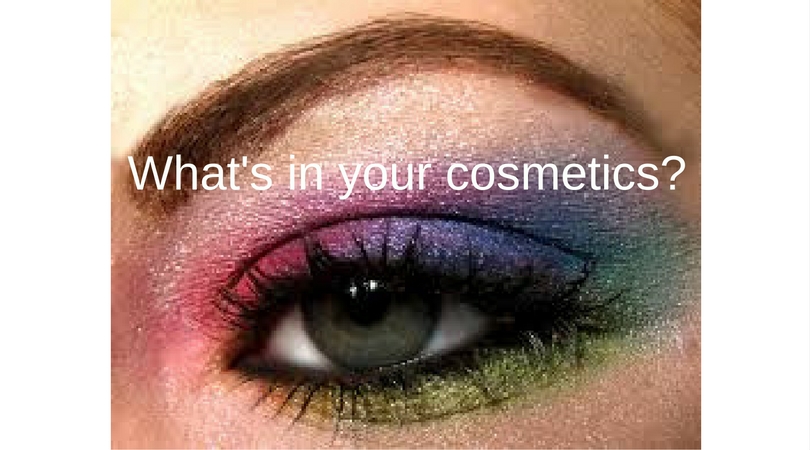
The David Suzuki Foundation produced a report in 2010 outlining the toxic substances in cosmetics, followed by recommendations to protect our health. We chose to highlight them here, as many of them increase breast cancer risk.
Here are the Dirty Dozen Chemicals:
(More detailed info at davidsuzuki.org/dirtydozen/)
- BHA and BHT: Used mainly in moisturizers and makeup as preservatives. Suspected endocrine disruptors and may cause cancer (BHA). Harmful to fish and other wildlife.
- Coal tar dyes: p-phenylenediamine and colours listed as “CI” followed by five digits. P-phenylenediamine is used in some hair dyes; other colours are used in a variety of cosmetics. Potential to cause cancer and may be contaminated with heavy metals toxic to the brain.
- DEA-related ingredients: Used in some creamy and foaming products, such as moisturizers and shampoos. Can react to form nitrosamines, which may cause cancer. Harmful to fish and other wildlife.
- Dibutyl phthalate: Used as a plasticizer in some nail care products. Suspected endocrine disrupter, linked with breast cancer, and is a reproductive toxicant. Harmful to fish and other wildlife.
- Formaldehyde-releasing preservatives: Used in a variety of cosmetics. Slowly release small amounts of formaldehyde, which causes cancer.
- Paraben, methylparaben, butylparaben and propylparaben: Used in a variety of cosmetics as preservatives. Suspected endocrine disrupters and may interfere with male reproductive functions as well as may cause breast cancer.
- Parfum/Perfume: Any mixture of fragrance ingredients used in a variety of cosmetics. Some fragrance ingredients can trigger allergies and asthma. Some linked to cancer and neurotoxicity. Some harmful to fish and other wildlife.
- PEGs (e.g., PEG -60): Used in some cosmetic cream bases. Can be contaminated with 1,4-dioxane, which may cause cancer.
- Petrolatum: Used in some hair products for shine and as a moisture barrier in some lip balms, lip sticks and moisturizers. Can be contaminated with polycyclic aromatic hydrocarbons, which may cause cancer.
- Siloxanes: Used in a variety of cosmetics to soften, smooth and moisten. Suspected endocrine disrupter and reproductive toxicant (cyclotetrasiloxane). Harmful to fish and other wildlife.
- Sodium laureth sulfate: Used in some foaming cosmetics, such as shampoos, cleansers and bubble bath. Can be contaminated with 1,4-dioxane, which may cause cancer.
- Triclosan: Used in some antibacterial cosmetics, such as toothpastes, cleansers and deodorants. Suspected endocrine disrupter and may contribute to antibiotic resistance in bacteria. Harmful to fish and other wildlife.
Loopholes in Canada’s Cosmetics Laws
- Manufacturers are not required to disclose specific fragrance ingredients on the product label. Instead, the generic term parfum is listed, representing a mixture of potentially dozens of chemicals.
- Products regulated as “drugs” on the basis of therapeutic claims (e.g., tartarfighting toothpaste, bacteria-killing cleansers, face cream with sun protection) are only required to list ‘active’ ingredients, not a complete list as required for products regulated as cosmetics.
- Although most ingredients in cosmetics have never been tested for their effects on human health and the environment, Health Canada does not require pre-market testing of chemicals used in cosmetics.
- Under Canada’s Cosmetic Regulations, manufacturers are required to disclose the concentration of each ingredient in their product to the Minister of Health, but this information is not made public.
- Chemicals that are prohibited or restricted may still be present in cosmetics as byproducts or impurities
- Manufacturers are not required to disclose specific fragrance chemicals in the list of ingredients
- Products marketed as “fragrance-free” or “unscented” may contain fragrance ingredients, in the form of masking agents that prevent the brain from perceiving odour.
Recommendations
- Replace potentially harmful ingredients in cosmetics with safer alternatives.
- As an interim step, implement hazard labelling for ingredients linked to chronic health concerns and strengthen EcoLogo™ certification criteria for personal care products.
- Require pre-market approval of the chemical composition of cosmetics and allow public access to a searchable online database of information submitted by manufacturers.
- Extend restrictions on cosmetic ingredients to “unintentional ingredients” (e.g., impurities, by-products).
- Extend ingredient restrictions and labelling requirements to personal care products regulated as “drugs.”
- Require manufacturers to disclose specific fragrance ingredients.
- Prohibit use of the terms unscented and fragrance-free in the marketing of products that contain fragrance ingredients (including masking agents).
- Prohibit anti-bacterial household products, including cosmetics.
- Restrict use of the terms natural and organic in the marketing of products that contain non-organic and synthetic ingredients.
- Extend ingredient disclosure requirements to other types of consumer products, including household cleaners, toys and furnishings.
Take Action:
Demand L’Oreal remove chemicals linked to breast cancer from anti-aging products
Would you put Teflon on your face? Did you know some L’Oréal anti-aging creams and face powders use the same chemical that creates a nonstick surface on some cookware to create a smooth finish to makeups and lotions?
That’s a recipe for concern, because PTFE can be contaminated with perfluorooctanoic acid (PFOA) — a toxic chemical linked to cancer, endocrine disruption and reproductive harm. PTFE is the same chemical known by the trade name Teflon.
A recent report published by the Campaign for Safe Cosmetics and the Breast Cancer Fund found PFOA in over one-third of the personal care products tested including:
– L’Oréal’s Garnier Fructis Ultra-Lift Transformer Anti-Age Skin Corrector
– L’Oréal’s Garnier Fructis Ultra-Life Anti-Wrinkle Firming Moisturizer

Send a letter to L’Oreal here



